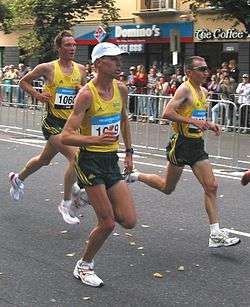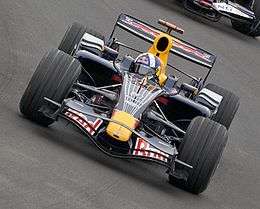Triathlon
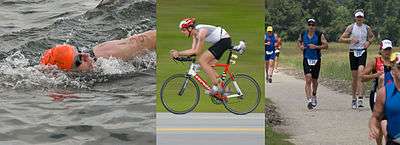 The three typical components of triathlon: swimming, cycling, and running. | |
| Highest governing body | International Triathlon Union |
|---|---|
| First played | 1920s |
| Characteristics | |
| Contact | No |
| Mixed gender | Yes, separate competitions |
| Type | Endurance sport |
| Presence | |
| Country or region | Worldwide |
| Olympic | Yes, since 2000 |
| Paralympic | Yes, Paratriathlon since 2016 |
| World Games | 1989 (invitational) – 1993 |
A triathlon is a multisport race with three continuous and sequential endurance races.[1] The word is of Greek origin, from τρεῖς or treis (three) and ἆθλος or athlos (competition).[2]
While variations of the sport exist, the most common form includes swimming, cycling, and running over various distances. Triathletes compete for fastest overall course completion, including timed transitions between the three races.[1]
A transition area is set up where the athletes change gear for different segments of the race. This is where the switches from swimming to cycling and cycling to running occur. These areas are used to store bicycles, performance apparel, and any other accessories needed for the next stage of the race. The transition from swim to bike is referred to as T1 and that between the bike and run is referred to as T2. The athlete's overall time for the race includes time spent in T1 and T2.[3] Transition areas vary in size depending on the number of participants expected. In addition, these areas provide a social headquarters before the race.[4]
The nature of the sport focuses on persistent and often periodized training in each of the three disciplines, as well as combination workouts and general strength conditioning.[5]
History
Triathlon is considered by some to have its beginnings in 1920s France.[6] According to triathlon historian and author Scott Tinley (and others[7]), the origin of triathlon is attributed to a race during the 1920s–1930s that was called variously "Les trois sports", "La Course des Débrouillards", and "La course des Touche à Tout." This race is held every year in France near Joinville-le-Pont, in Meulan and Poissy.
An earlier tri-sport event in 1902 featured running, cycling, and canoeing.[7] There are documented tri-sport events featuring running, swimming, & cycling (not necessarily in that order) in 1920, 1921, 1945, and the 1960s.[7] In 1920, the French newspaper L´Auto reported on a competition called "Les Trois Sports" with a 3 km (1.9 mi) run, 12 km (7.5 mi) bike, and a swim across the channel Marne. Those three parts were done without any break. Another event was held in 1921 in Marseilles with the order of events bike-run-swim.[7] French newspapers reported on a race in Marseille in 1927, and in 1934 an article about "Les Trois Sports" (the three sports) in the city of La Rochelle was written about a race with: (1) a channel crossing (c. 200 m [660 ft]), (2) a bike competition (10 km [6.2 mi]) around the harbor of La Rochelle and the parc Laleu, and (3) a run (1,200 m [3,900 ft]) in the stadium André-Barbeau.[8]
Modern triathlon
The first modern swim/bike/run event to be called a 'triathlon' was held at Mission Bay, San Diego, California on September 25, 1974. The race was conceived and directed by Jack Johnstone and Don Shanahan, members of the San Diego Track Club, and was sponsored by the track club. 46 participants entered this event. It was reportedly not inspired by the French events,[9] although a race the following year at Fiesta Island, San Diego, California, is sometimes called 'the first triathlon in America.'[6]
Organizations
The International Triathlon Union (ITU) was founded in 1989 as the international governing body of the sport, with the chief goal, at that time, of putting triathlon on the Olympic program.[10] The ITU sanctions and organizes the World Cup and World Triathlon Series races each year, with annual world champions crowned each year for elite pro-triathletes, junior pro-triathletes, and age-group athletes (in 5-year age-groups). ITU races are conducted in a draft legal format for the bike leg, whereas drafting is not permitted at the amateur level. In addition, the ITU has a Long Distance Triathlon series.
The World Triathlon Corporation (WTC) is a private company that sanctions and organizes the Ironman and Ironman 70.3 races each year. These races serve as qualifying events for their own annual World Championships. The Ironman World Championship is held annually in Kailua-Kona, Hawaii in October while the Ironman 70.3 World Championship is held in September and changes location each year. The "Ironman" and "Iron" brands are property of the WTC. Therefore, long-distance multi-sport events organized by groups other than the WTC may not officially be called "Ironman" or "Iron" races.[11] For its part, the ITU does not sanction WTC races;[12] however, USAT uses a combination of ITU and WTC rules to sanction WTC's branded events.[13] The Challenge Family brand produces long-distance events around the world, and includes events like Challenge Roth.[14]

International Ultra-Triathlon Association (IUTA) is the official governing body of Ultratriathlon, which involves triathlon in distances longer than an iron-distance race.[15]
Olympics
The sport made its debut on the Olympic program at the Sydney Games in 2000 over the Olympic Distance (swim: 1,500 m [1,650 yd] – bike: 40 km [24.9 mi] – run: 10 km [6.2 mi]).
Paralympics
Paratriathlon at the Summer Paralympics debuted at the 2016 Summer Paralympics held in Rio de Janeiro, Brazil.[16][17]. Paratriathlon is a variant of the triathlon for athletes with a physical disability. The Paralympic event originally scheduled a sprint race with athletes competing in six categories according to the nature of their physical impairments.[18][19]
Race formats
| Name | Swim | Bicycle | Run | Notes |
|---|---|---|---|---|
| Kids of Steel | 100–750 m (110–820 yd) | 5–15 km (3.1–9.3 mi) | 1–5 km (0.62–3.11 mi) | Distances vary with age of athlete. See: Ironkids |
| Novice (Australia) | 300 m (330 yd) | 8 km (5.0 mi) | 2 km (1.2 mi) | Standard novice distance course in Australia (often called enticer triathlons). |
| 3–9–3 (New Zealand) | 300 m (330 yd) | 9 km (5.6 mi) | 3 km (1.9 mi) | Standard novice distance course in New Zealand. |
| Super Sprint | 400 m (0.25 mi) | 10 km (6.2 mi) | 2.5 km (1.6 mi) | Standard Super Sprint course. |
| Novice (Europe) | 400 m (0.25 mi) | 20 km (12 mi) |
5 km (3.1 mi) | Standard novice/fitness distance course in Europe. |
| Sprint | 750 m (0.47 mi) | 20 km (12 mi) |
5 km (3.1 mi) | Half the Olympic distance. For pool-based races, a 400 or 500 m (1,300 or 1,600 ft) swim is common. |
| Olympic | 1.5 km (0.93 mi) | 40 km (25 mi) | 10 km (6.2 mi) | Also known as "international distance", "standard course", or "short course". |
| Triathlon 70.3 | 1.9 km (1.2 mi) | 90 km (56 mi) | 21.1 km (13.1 mi) | Also known as "middle distance", "70.3" (total miles traveled), or "half-ironman". |
| ITU-Long Distance (O2) | 3.0 km (1.9 mi) | 80 km (50 mi) | 20 km (12 mi) | Double Olympic Distance[20] distance of the ITU Long Distance Triathlon World Championships 2007 and 2009. |
| Triathlon 140.6 | 3.9 km (2.4 mi) | 181 km (112 mi) | 42.2 km (26.2 mi) | Also known as "long distance", "full distance", "140.6" (total miles traveled), or "Ironman Triathlon".[21] |
| ITU-Long Distance (O3) | 4.0 km (2.5 mi) | 120 km (75 mi) | 30 km (19 mi) | So-called triple Olympic Distance,[20] distance of the ITU Long Distance Triathlon World Championships most years including 2011. |
| Source:[22][23] | ||||
Triathlons longer than full distance are classed as Ultra-triathlons.
Triathlons are not necessarily restricted to these prescribed distances. Distances can be any combination of distance set by race organizers to meet various distance constraints or to attract a certain type of athlete.
The standard Olympic distance of 1.5/40/10 km (0.93/24.8/6.2 miles) was created by longtime triathlon race director Jim Curl in the mid-1980s, after he and partner Carl Thomas produced the U.S. Triathlon Series (USTS) between 1982 and 1997.[24]
In addition to the above distances, two new long distance events have appeared, the 111 and 222 events. The 111 distance is 1 km (0.62 mi) swimming, 100 km (62 mi) bicycling and 10 km (6.2 mi) running, totalling 111 km (69 mi). The 222 distance is double that.[25]
Most triathlons are individual events. Another format is relay triathlons, where a team of competitors take turns to compete at a race; each competitor must do a segment of swimming, cycling and running. The ITU Team Triathlon World Championships began with two separate classifications for men and women. In 2009, it adopted a 4x4 mixed relay format, where each team has two men and two women. The Youth Olympic Games also has a 4x mixed relay triathlon event.
The ITU accepts a 5% margin of error in the cycle and run course distances.[26] Though there can be some variation in race distances, particularly among short triathlons, most triathlons conform to one of those above standards.
Race organization
In general, participation in a triathlon requires an athlete to register and sign up in advance of the actual race. After registration, racers are often provided a race number, colored swim cap, and, if the event is being electronically timed, a timing band. Athletes will either be provided or briefed on details of the course, rules, and any problems to look out for (road conditions, closures, traffic lights, aid stations).[27] At a major event, such as an Ironman or a long course championship, triathletes may be required to set up and check-in their bike in the transition area a day or two before the race start, leaving it overnight and under guard.[28]
On the day of the race, before the start of competition, athletes will generally be provided with a bike rack to hold their bicycle and a small section of ground space for shoes, clothing, etc. in the transition area. In some triathlons, there are two transition areas, one for the swim/bike change, then one for the bike/run change at a different location.[29]
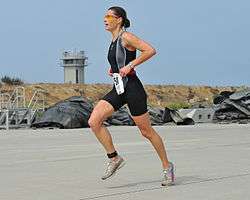
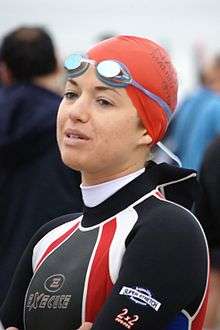
Racers are generally categorized into separate professional and amateur categories. Amateurs, who make up the large majority of triathletes, are often referred to as "age groupers" since they are typically further classified by sex and age; which offers the opportunity to compete against others of one's own gender and age group. The age groups are defined in five- or ten-year intervals.[29] There is typically a lower age limit; which can vary from race to race. In some triathlons, heavier amateur athletes may have the option to compete against others closer to their own weight since weight is often considered an impediment to speed. As an example, under USA Triathlon rules, "Clydesdale" athletes are those men over 220 lb (100 kg), while "Athena" athletes are women over 165 lb (75 kg).[30] Other races and organizations can choose whether or not to offer Clydesdale- and Athena-type divisions and set their own weight standards.
Depending on the type and size of the race, there may be any of the following methods implemented to start the race. In a mass start, all athletes enter the water and begin the competition following a single start signal. In wave start events, smaller groups of athletes begin the race every few minutes. An athlete's wave is usually determined either by age group or by predicted swim time. Wave starts are more common in shorter races where a large number of amateur athletes are competing.[31] Another option is individual time trial starts, where athletes enter the water one at a time, a few seconds apart.[32]
The swim leg usually proceeds around a series of marked buoys before athletes exit the water near the transition area. Racers exit out of the water, enter the transition area, and change from their swim gear and into their cycling gear. Competition and pressure for faster times have led to the development of specialized triathlon clothing that is adequate for both swimming and cycling, allowing many racers to have a transition that consists of only removing their wetsuit, cap, and goggles and pulling on a helmet and cycling shoes. In some cases, racers leave their cycling shoes attached to their bicycle pedals and slip their feet into them while riding. Some triathletes don't wear socks, decreasing their time spent in transition even more.
The cycling stage proceeds around a marked course, typically on public roads. In many cases, especially smaller triathlons, roads are not closed to automobiles; however, traffic coordinators are often present to help control traffic. Typically, the cycling stage finishes back at the same transition area. Racers enter the transition area, rack their bicycles, and quickly change into running shoes before heading out for the final stage. The running stage usually ends at a separate finish line near the transition area.
In most races, "aid stations" located on the bike and run courses provide water and energy drinks to the athletes as they pass by. Aid stations at longer events may often provide various types of food as well, including such items as energy bars, energy gels, fruit, cookies, soup, and ice.
Once the triathletes have completed the event, there is typically another aid station for them to get water, fruit, and other post-race refreshments. Occasionally, at the end of larger or longer events, the provided amenities and post-race celebrations may be more elaborate.
Rules of triathlon
While specific rules for triathlon can vary depending on the governing body (e.g. USA Triathlon, ITU), as well as for an individual race venue, there are some basic universal rules. Traditionally, triathlon is an individual sport and each athlete is competing against the course and the clock for the best time. As such, athletes are not allowed to receive assistance from anyone else outside the race, with the exception of race-sanctioned aid volunteers who distribute food and water on the course.[33][34]

Triathlons are timed in five sequential sections:
- from the start of the swim to the beginning of the first transition (swim time);
- from the beginning of the first transition to the end of the first transition (T1 time);
- from the start of the cycling to the end of the cycling leg (cycling time);
- from the beginning of the second transition to the end of the second transition (T2 time);
- finally from the start of the run to the end of the run, at which time the triathlon is completed.[34]
Results are usually posted on official websites and will show for each triathlete his/her swim time; cycle time (with transitions included); run time; and total time. Some races also post transition times separately.
Other rules of triathlon vary from race to race and generally involve descriptions of allowable equipment (for example, wetsuits are allowed in USAT events in the swimming stage of some races when the water temperature is below 78.1 °F [25.6 °C]),[30] and prohibitions against interference between athletes.[34] Additionally, the use of flippers or other swim propulsion and flotation aids are illegal in triathlon and can result in disqualification.[30]
One rule involving the cycle leg is that the competitor's helmet must be donned before the competitor mounts (or even takes possession of, in certain jurisdictions[35]) the bike and must remain on until the competitor has dismounted; the competitor is not required to wear the helmet when not on the bicycle (e.g. while repairing a mechanical problem). Failure to comply with this rule will result in disqualification.[30][34] Additionally, while on the bike course, all bicycles shall be propelled only by human force and human power. Other than pushing a bicycle, any propulsive action brought on by use of the hands is prohibited. Should a competitor's bike malfunction they can proceed with the race as long as they are doing so with their bicycle in tow.[30] There are also strict rules regarding the 'bike mount' line. Competitors may not begin riding their bicycle out of transition until they are over a clearly marked line. Mounting the bike prior to this may incur a penalty (example: a 15-second time penalty at the London 2012 Olympics was awarded to Jonathan Brownlee, a competitor from Great Britain, for mounting his bike too early.)[34][36]
Other time penalties can be incurred during the race for, among other things, drafting on the bike in a non-drafting race, improper passing, littering on course, and unsportsmanlike conduct.[30][37]
Triathlon and fitness
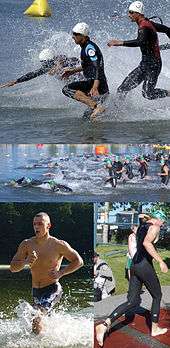
Participants in triathlon often use the sport to improve or maintain their physical fitness.[38][39] With each sport being an endurance event, training for a triathlon provides cardiovascular exercise benefits.[40] Additionally, triathletes encounter fewer injuries than those who only use running as part of their exercise routine due to the incorporation of low impact swim and bike training.[41]
Triathletes spend many hours training for competitions, like other endurance event participants.[42] There are three components that have been researched to improve endurance sports performance; aerobic capacity, lactate threshold, and economy.[43] Injuries that are incurred from long hours of a single activity are not as common in triathlon as they are in single sport events. The cross-training effect that athletes achieve from training for one sport by doing a second activity applies to triathlon training.[41] Additional activities that triathletes perform for cross-training benefits are yoga, pilates, and weight training.[44]
Swimming
Triathletes will often use their legs less vigorously and more carefully than other swimmers, conserving their leg muscles for the cycle and run to follow. Many triathletes use altered swim strokes to compensate for turbulent, aerated water and to conserve energy for a long swim. In addition, the majority of triathlons involve open-water (outdoor) swim stages, rather than pools with lane markers. As a result, triathletes in the swim stage must jockey for position, and can gain some advantage by drafting, following a competitor closely to swim in their slipstream. Triathletes will often use "dolphin kicking" and diving to make headway against waves, and body surfing to use a wave's energy for a bit of speed at the end of the swim stage. Also, open-water swims necessitate "sighting": raising the head to look for landmarks or buoys that mark the course. A modified stroke allows the triathlete to lift the head above water to sight without interrupting the swim or wasting energy.
Because open water swim areas are often cold and because wearing a wetsuit provides a competitive advantage, specialized triathlon wetsuits have been developed in a variety of styles to match the conditions of the water. For example, wetsuits that are sleeveless and cut above the knee are designed for warmer waters, while still providing buoyancy. Wetsuits are legal in sanctioned events at which the surface water temperature is 78 °F (26 °C) or less.[30] In non-sanctioned events or in "age group" classes where most racers are simply participating for the enjoyment of the sport instead of vying for official triathlon placing, wetsuits can often be used at other temperatures. Race directors will sometimes discourage or ban wetsuits if the water temperature is above 84 °F (29 °C) due to overheating that can occur while wearing a wetsuit.[45] Other rules have been implemented by race organizers regarding both wetsuit thickness as well as the use of "swim skins;" which need to be considered by those participating in future triathlons. Some triathlon sanctioning bodies have placed limits on the thickness of the wetsuit material. Under ITU and some national governing bodies' rules no wetsuit may have a thickness of more than 5 mm (0.20 in).[46]
Cycling

Triathlon cycling can differ from most professional bicycle racing depending on whether drafting is allowed during competition. In some competitions, like those governed by USA Triathlon and the World Triathlon Corporation, drafting is not allowed,[30] and thus the cycling portion more closely resembles individual time trial racing. In other races, such as those in World Cup and Championship racing, drafting and the formation of pelotons are legal.[1][34] This places an emphasis on running performance as several athletes will enter the bike to run transition at the same time due to drafting.[47]
Triathlon bicycles are generally optimized for aerodynamics, having special handlebars called aero-bars or tri-bars, aerodynamic wheels, and other components. Triathlon bikes use a specialized geometry, including a steep seat-tube angle both to improve aerodynamics and to spare muscle groups needed for running (see also triathlon equipment). At the end of the bike segment, triathletes also often cycle with a higher cadence (revolutions per minute), which serves in part to keep the muscles loose and flexible for running.
Running

The primary distinguishing feature of running in a triathlon is that it occurs after the athlete has already been exercising in two other disciplines for an extended period of time, so many muscles are already tired. The effect of switching from cycling to running can be profound; first-time triathletes are often astonished at their muscle weakness, which may be caused by lactate accumulation and the bizarre, sometimes painful sensation in their thighs a few hundred yards into the run, and discover that they run at a much slower pace than they are accustomed to in training. Triathletes train for this phenomenon through transition workouts known as "bricks": back-to-back workouts involving two disciplines, most commonly cycling and running.
Transition
The change over from sport to sport takes place in a designated transition area. The transition provides a staging area where bicycles, running shoes, hydration and other gear is set up ready to be used during the course of the event. The first transition, known as T1, is between the swim-to-bike segments of the race. The second transition, T2, is between the bike-to-run segments. Most events have one common transition area for both T1 and T2, while some point to point events have two separate transition areas. The time spent in transition is a timed segment and contributes towards the overall finishing time of the event.
Notable events
Thousands of individual triathlons are held around the world each year. A few of these races are well known because they have a long history or because they have particularly grueling courses and race conditions. A few are listed here.
ITU-sanctioned events
- World competitions
- ITU World Triathlon Series
- ITU Triathlon World Cup
- ITU Long Distance Triathlon World Championships
- ITU Sprint Distance Triathlon World Championships
- ITU Triathlon Mixed Relay World Championships
- Multi-sport events
Other events
- Hawaii Ironman World Championship, Kona, Hawaii. First held in 1978 on Oahu, only five years after the sport of triathlon was founded; it was later moved to Kailua-Kona on the island of Hawaii. The cycling stage of the race covers more than 100 mi (160 km) over lava flats on the big island of Hawaii, where mid-day temperatures often reach over 110 °F (43 °C) and cross-winds sometimes blow at 55 mph (89 km/h). The race is often challenging even to competitors with experience in other iron-distance events. Being a world championship race, only competitors that meet qualifying guidelines can enter, typically qualifying slots are awarded in other Ironman sanctioned events.
- Nice Triathlon, Nice, France. A race that existed until 2002 when the course was adopted by the WTC as Ironman France. During the 1980s the Nice Long Distance triathlon (swim 4 km [2.5 mi], bike 120 km [75 mi], run 30 km [19 mi]) was, alongside the World Championships in Kona, one of the two important races each year with prize money and media attention. Mark Allen won here 10 consecutive times. The ITU's Long Distance is a Nice-Distance race except during a short period from late 2006 to early 2008, in which it was 3 km (1.9 mi) + 80 km (50 mi) + 2 km (1.2 mi).
- Enduroman Arch to Arc. A 465-kilometre (289 mi) triathlon from Marble Arch, London to the Arc de Triomphe, Paris. Run from Marble Arch in London to Dover 140 kilometres (87 mi), swim the English Channel 35 kilometres (22 mi) to Calais, and then cycle 291 kilometres (181 mi) from Calais to Paris. For this challenge, the clock starts at Marble Arch and stops at Arc de Triomphe. Only 24 people in history have completed this event.
- St. Anthony's, St. Petersburg, Florida. Held in the last week of April every year, this race attracts professional and amateur triathletes from around the world. One of the largest Olympic Distance triathlon in the U.S. with over 4,000 participants each year.
- Escape from Alcatraz, San Francisco, California. This non-standard-length race begins with a 1.5-mile (2.4 km) swim in frigid San Francisco Bay waters from Alcatraz Island to shore, followed by an 18-mile (29 km) bicycle and 8-mile (13 km) run in the extremely hilly terrain of the San Francisco Bay Area. The run includes the notorious "Sand Ladder", a 400-step staircase climb up a beachside cliff.
- Wildflower is a half-iron distance race held on the first weekend of May at Lake San Antonio on the Central Coast of California since 1983. Known for a particularly hilly course, it has expanded now to include three races of different lengths and is one of the largest triathlon events in the world, with over 8,000 athletes attending each year.
- Life Time Fitness Triathlon Series. Life Time Tri Series is a series of 5 Olympic distance races: The Lifetime Fitness in Minneapolis, the NYC Triathlon in New York City, the Chicago Triathlon, the LA Triathlon in Los Angeles, and the U.S. Open in Dallas. There is a combined $1.5 Million prize purse at stake for the professionals who come from around the world to take part in the series.
- Hy-Vee Triathlon, started in 2007 by the mid-west grocery store chain Hy-Vee. The race has the richest prize purse awarded for a single triathlon. Formally part of the ITU Triathlon World Cup series from 2008 to 2010 it now serves as the World Triathlon Corporation's 5150 Series U.S. Championships.
- Norseman Extreme Triathlon, Hardangerfjord, Norway. Norseman is an Ironman-distance triathlon that starts with a swim in the Hardangerfjord and finishes on top of a Gaustatoppen mountain at 1,850 m (6,070 ft) above sea level. Famous for its lower temperatures and 5,000 m (16,000 ft) total ascent, this race accepts only 200 competitors each year.
- Ironman 70.3 World Championship
- Grand Prix de Triathlon, the French club championship series sponsored by Lyonnaise des Eaux. The circuit comprises five triathlons and by the French Triathlon Federation and attracts professional international triathletes hired by French triathlon clubs.
- Triathlon EDF Alpe d'Huez, established in 2006 by the 2002 Long Distance World Champion Cyrille Neveu, is one of the best known single triathlons in France.
Paratriathlon
Paratriathlon is a variant of the triathlon for athletes with physical disabilities. The sport was accepted by the International Paralympic Committee and debuted at the 2016 Summer Paralympics held in Rio de Janeiro, Brazil.[48]
The annual ITU Triathlon World Championships includes a paratriathlon sprint distance event with a 750 m (2,460 ft) swim, 20 km (12 mi) bike using handcycles, bicycles, tricycles or tandem bicycles with a guide and a 5 km (3.1 mi) wheelchair or running race. Athletes compete in six categories according to the nature of their physical impairments.[49]
Nonstandard variations
- Aquabike, composed of only swimming and cycling stages.
- Aquathlon, composed of only swimming and running stages.
- Swimrun, composed of alternating swimming and running stages. The best-known event is the ÖTILLÖ Swimrun World Series in Utö - Sweden.
- Duathlon, composed of only cycling and running stages.
- Equilateral triathlon, a triathlon in which each leg takes approximately equal time.
- Indoor triathlon, consisting of a pool swim, stationary bike, and indoor track or treadmill run.
- Cross triathlon, consists of swimming, mountain biking and trail running. The best-known series of these races is known as the XTERRA Triathlon.
- Ultraman triathlon, an Ultra-long distance three-day triathlon covering 510 kilometres (320 mi) in separate stages.
- Winter triathlon, typically includes two events of either cross-country skiing, mountain biking or outdoor-ice speed skating and finishes with running.
- SUPBIKERUN triathlon, consisting of Standup paddleboarding (SUP), Trail running and Mountain biking. Designed as an entry level triathlon [50]
See also
References
- 1 2 3 Garrett, William E.; Kirkendall, Donald T. (2000). Exercise and sport science. Lippincott Williams & Wilkins. p. 919. ISBN 978-0-683-03421-9.
- ↑ Matlow, Jeff (Winter 2011). "Tiredathlon". USA Triathlon Life. p. 101.
- ↑ Mora, John (2009). Triathlon 101 (2 ed.). Human Kinetics. p. 149. ISBN 978-0-7360-7944-0.
- ↑ Schneider, Terri (2008). Triathlon Revolution: Training, Technique, and Inspiration. The Mountaineers Books. p. 138. ISBN 978-1-59485-096-7.
- ↑ Holland, Tom (2005). "Chapter 9: Triathlon Training". The 12-Week Triathlete: Train for a Triathlon in Just Three Months. Fair Winds. pp. 123–129. ISBN 978-1-59233-126-0.
- 1 2 "ESPN – Triathlon milestones". Sports.espn.go.com. Retrieved 2012-07-02.
- 1 2 3 4 "Tri Sports History Timeline (1902–2008)". Archived from the original on March 31, 2010. Retrieved December 19, 2012.
- ↑ Mechikoff, Robert (2009). A history and philosophy of sport and physical education: from ancient civilizations to the modern world. McGraw-Hill. p. 279. ISBN 9780073376493.
- ↑ Tinley, Scott. Triathlon' A Personal History by Scott Tinley. p. 6.
- ↑ "Olympic History: Triathlon". CBS Sports. Retrieved 4 October 2010.
- ↑ Williams, Pete (8 April 2008). "Iron Man calls this fight a draw". Street & Smith's Sports Group. Retrieved 24 June 2010.
- ↑ "Congress votes to no longer sanction Ironman". International Triathlon Union. 14 September 2005. Retrieved 4 October 2010.
- ↑ "Ironman and USAT are again brothers in arms". Slowtwitch.com. 27 March 2006. Archived from the original on 18 July 2011. Retrieved 4 October 2010.
- ↑ "About Challenge Family". TEAMChallenge. Archived from the original on January 6, 2014. Retrieved February 26, 2014.
- ↑ "International Ultra-Triathlon Association". International Ultra Triathlon Association. Retrieved 28 September 2011.
- ↑ "Paratriathlon added to the Rio 2016 Paralympic Games | Triathlon.org - International Triathlon Union". Triathlon.org. Retrieved 2012-06-19.
- ↑ "Paratriathlon". Rio 2016. 1989-08-06. Archived from the original on 2013-12-06. Retrieved 2013-06-20.
- ↑ "Para-Triathlon | IPC". Paralympic.org. Retrieved 2012-06-19.
- ↑ "Paratriathlon - Triathlon.org - The Official Triathlon Resource". Triathlon.org. Retrieved 2012-06-19.
- 1 2 "ITU Competition Rules 2008" (PDF). p. 52. Retrieved 2012-07-02.
- ↑ Because "Ironman Triathlon" is a registered trademark of the World Triathlon Corporation (WTC), only races licensed by the WTC may be called "Ironman" or "Iron". As a result, other races of the same distances are called "full" or "long" distance.
- ↑ "Appendix A | Category Rules | Downloads | Triathlon.org". www.triathlon.org. Retrieved 2016-02-07.
- ↑ "Race Distances Defined". Team USA. Retrieved 2016-02-07.
- ↑ "USA Triathlon Hall of Fame Banquet Caps Memorable Weekend". USA Triathlon. 14 January 2010. Archived from the original on 7 January 2011. Retrieved 4 October 2010.
- ↑ "TriStar Triathlon Events". Star Production SARL. Archived from the original on 14 March 2012. Retrieved 22 February 2012.
- ↑ International Triathlon Union (2003). "ITU Competition Rules" (PDF). Archived from the original (PDF) on 2006-06-14. Retrieved 2005-12-13.
- ↑ Watson, Lance; Motz, Jason (2010). First Triathlon: Your Perfect Plan to Success. Meyer & Meyer Verlag. pp. 13–16. ISBN 978-1-84126-116-4.
- ↑ "2009 Athlete Information Guide – Ironman World Championship" (PDF). Ironman – World Triathlon Corporation. 2009. p. 9. Archived from the original (PDF) on 7 October 2009. Retrieved 15 June 2010.
- 1 2 Plant, Mike (1987). Triathlon: going the distance. Contemporary Books. ISBN 978-0-8092-4774-5.
- 1 2 3 4 5 6 7 8 "USA Triathlon Competitive Rules". USA Triathlon. January 2013. Retrieved March 5, 2014.
- ↑ Hanlon, Thomas W. (2009). The sports rules book (3 ed.). Human Kinetics. p. 272. ISBN 978-0-7360-7632-6.
- ↑ "Age Group Time Trial Swim Start". HRMS Naperville Sprint Triathlon. 2010. Archived from the original on 10 August 2009. Retrieved 23 September 2010.
- ↑ "2010 Most Common Rules Violations" (PDF). USA Triathlon. 2010. Archived from the original (PDF) on June 1, 2010. Retrieved March 2, 2017.
- 1 2 3 4 5 6 "ITU Competition Rules" (PDF). International Triathlon Union. 23 January 2010. Retrieved 4 October 2010.
- ↑ "Triathlon Québec Règles de compétition" (PDF) (in French). Triathlon Québec. 2008-05-17. Retrieved 2013-06-27.
- ↑ "Alistair Brownlee storms to Olympic gold at London 2012". International Triathlon Union. August 2012. Retrieved June 25, 2013.
- ↑ "Rules Education: Time Penalties". USA Triathlon. Retrieved March 5, 2014.
- ↑ Harr, Eric (6 July 2005). "20 Great Reasons to do a Triathlon". Men's Health. Retrieved 2 June 2011.
- ↑ Dallam, George M. (2008). Championship Triathlon Training. Human Kinetics. p. 286. ISBN 978-0-7360-8154-2.
- ↑ "Cardio Exercise Ideas". Livestrong.com. Retrieved 2 June 2011.
- 1 2 Smith, Stew. "Triathlon Training". Military.com. Retrieved 2 June 2011.
- ↑ Finch, Michael (2004). Triathlon Training. Human Kinetics. p. 71. ISBN 978-0-7360-5444-7.
- ↑ Friel, Joe (2010). Your Best Triathlon. p. 15.
- ↑ Gandolfo, Christina (2005). The Woman Triathlete. Human Kinetics. pp. 200–201. ISBN 978-0-7360-5430-0.
- ↑ "At what temps can you use a wetsuit?". TriathlonWetsuitStore.com. Retrieved 2011-03-17.
- ↑ "USA Triathlon Adopts New Wetsuit Regulation Starting In 2013". Competitor Group, Inc. June 21, 2010. Retrieved June 4, 2013.
- ↑ Friel, Joe (2004). The Triathlete's Training Bible. VeloPress. ISBN 978-1-931382-42-7.
- ↑ "Paratriathlon added to the Rio 2016 Paralympic Games". Triathlon.org - International Triathlon Union. Retrieved 13 June 2012.
- ↑ "Parathriathlon". Triathlon.org - International Triathlon Union. Retrieved 13 June 2012.
- ↑ "A rookie's guide to #SUPBIKERUN – Part 1". Supboardmag.com. Retrieved 23 September 2017.
Further reading
- Friel, Joe (1998). The Triathlete's Training Bible. na: VeloPress. ISBN 1-884737-48-X.
- Friel, Joe (2008). Going Long: Training for Ironman-Distance Triathlons. na: VeloPress. ISBN 978-1-934030-06-6.
- Friel, Joe (2006). Your First Triathlon. na: VeloPress. ISBN 978-1-931382-85-4.
- Bernhardt, Gale (2006). Training Plans for Multisport Athletes. na: VeloPress. ISBN 978-1-931382-92-2.
- Bernhardt, Gale (2004). Triathlon Training Basics. na: VeloPress. ISBN 978-1-931382-25-0.
External links
| Wikimedia Commons has media related to Triathlon. |
